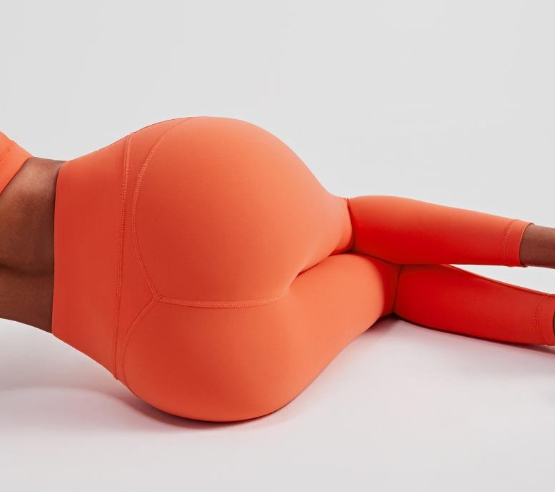Basic equipment in yoga practice, the design and comfort of yoga leggings strongly influence the practice impact and experience. The design of yoga leggings depends much on waist design. distinct waist styles provide distinct comfort and usefulness. The many basic waist designs of yoga leggings—high, low, mid-waist, adjustable waist design—will be thoroughly discussed in this article along with their pros and drawbacks and appropriate applications.

Design with high waist
Usually covering the whole belly, high waist yoga leggings are those with the waist design above the abdomen. Its pros and weaknesses as well as design elements follow:
traits:
All- Around assistance: Particularly during balance and strength training, the high waist shape may provide more complete abdominal support, therefore preserving a stable posture.
This design may assist to promote self-confidence, efficiently conceal the belly, and lessen waist visibility.
High waist yoga leggings may help to increase comfort by preventing the trousers from sliding, lowering the need for numerous modifications throughout practice, and therefore addressing comfort issues.
Advantages:
Good support: The high waist design may help specifically for yoga postures requiring core stability, including handstands or balancing poses, which can efficiently boost stability.
High-waisted leggings often have a particular shaping impact that may aid to shape a better body form and help to raise the waistline.
Drawbacks: Might not be fit for every body shape. Too high waists might feel constrictive or unpleasant for consumers with bigger abdomens.
Not appropriate for certain sports: The high waist shape might limit mobility and compromise comfort in some yoga poses needing more range of motion.
Appropriate usage cases:
Especially for postures requiring more abdominal support, high-waisted yoga leggings are appropriate for high-intensity yoga activities like power yoga and flow yoga. Furthermore there are high-waisted styles for customers who like complete coverage designs and want consistent support.
Low-waisted design
Usually covering just the lower belly, low-waisted yoga leggings have a waist design position lower than that of a navel. Its pros and weaknesses as well as design elements follow:
Specifications:
Comfortable and free: Usually looser and with more degree of flexibility, low-waisted designs fit those who value freedom.
Less constraint: Particularly for bigger users or those who need a greater range of motion during exercise, this design may help to lower abdominal pressure.
Benefits:
Travel freedom: Yoga exercises requiring flexibility, including bending and forward bending, would be suited for the broader range of motion made possible by the low waist design.
Less constraint: The low waist design releases more comfortable wearing experience by lowering waist constraint.
Opponents:
Low-waisted yoga pants are unfit for postures requiring great core stability and offer weak support in the belly.
Easy to slide: Low-waisted leggings require regular adjustments as they may slip during practice due to the low waist.
Low-intensity yoga activities like Yin yoga and restorative yoga call for low-waisted yoga pants. Those who require freedom and like a greater range of motion will find them appropriate.
Design with mid-waist lines Usually above or below the belly button, mid-waisted yoga pants’ waist design finds the center of the abdomen. Its pros and weaknesses as well as design elements follow:
Elements:
The mid-waist design combines the benefits of high waist and low waist, therefore offering modest support and comfort.
Versatility: This design may provide enough support and comfort and fit many yoga techniques.
Benefits include:
Moderate agreement: Without squeezing the abdomen, mid-waist yoga leggings provide a reasonable support and help to maintain the position of the trousers.
Usually having high flexibility, appropriate for most yoga positions, they also provide a pleasant wearing experience.
Conspects:
Might not be clear enough: The mid-waist shape may not be as successful as the high-waist version for consumers requiring more abdominal support.
Limited support: Particularly in high-intensity postures, the mid-waist design could not be as supporting as high-waist leggings.
Appropriate contexts for use:
Restorative yoga, flow yoga, and power yoga among other forms of yoga may all benefit from mid-waist yoga pants. Users who want a mix of comfort and support would be suited for them.
Adjustable waist design
Usually including adjustable belts, elastic bands or other adjustment tools, yoga leggings with varying waist design allow one to change the tightness of the waist depending on personal demand. Its pros and weaknesses as well as design elements follow:
characteristics:
Users may change the waist’s tightness in line with their comfort requirements and personal waist circumference.
This design may provide a customized wearing experience and accommodate users of various body shapes.
benefits:
Customized comfort: Users with the adjustable waist design may give ideal comfort by varying the waist tightness to suit their desire.
This design may provide improved adjustability for variations in body form or the need of various support.
Conspects:
could not be visually appealing: The legging’s general look could change depending on the adjusting tool.
Complex maintenance: The change device could call for more maintenance, therefore aggravating the wearing and maintenance complexity.
Yoga leggings with adjustable waist design are appropriate for those who need individualized adjustment—that is, those with significant changes in body form or those with particular need for waist support. Users that like adaptability and flexibility will also fit this design.
Thorough attention of waist design
The choice of waist design for yoga leggings should be thoroughly taken into account depending on the real demands and tastes of the person. These are some thorough ideas:
First of all, comfort: To guarantee comfort during practice, choose a waist style fit for your kind of yoga practice and body form.
Support needs: Choose a high waist design if you want greater abdominal support during practice; if you require wider range of motion, a low waist design might be better suited.
Type of activities: Select a waist design appropriate for the kind and degree of yoga practice. For extra support in high-intensity exercise, for instance, a high waist design might be required; for gentle practice, a low waist or mid-waist design can be used.

Yoga pants‘ waist shape strongly influences their comfort factor as well as their practice impact. Each of high, low, mid-waist, and adjustable waist designs has unique qualities, benefits and drawbacks as well as suitable situations. Selecting a good waist design calls for careful evaluation of personal comfort preferences, the degree and kind of yoga exercise, and personal body form. By means of a thorough examination of various waist styles, I aim to assist you in selecting the most appropriate yoga leggings thus enabling your yoga practice to be more comfortable and effective.



